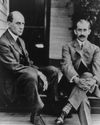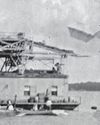CATEGORIES
Categories

Eye in the Sky
An interview with Joe Piotrowski

Airborne Animals
Humans have taken to the skies in balloons, gliders, and airplanes-but we're not alone among the clouds. Animals of all sorts have evolved to harness wind power.

TAKING OFF
The Wright brothers expected airplanes to “take off,” but even they might be amazed at the way the airline industry has become big business. In the past, it was expensive to send something by plane.

GROWTH OF AN INDUSTRY
After their historic flight at Kitty Hawk in 1903, Wilbur and Orville Wright returned to Dayton, Ohio. They spent the next few years making adjustments and building additional versions of their powered aircraft in their bicycle shop.

WHY KITTY HAWK?
The Wright brothers searched carefully for the best place to test their gliders and flying machines. Their main concern was for good, steady winds. But they also hoped to find a remote location to allow them to perform tests away from the public eye.

Two Brothers From Ohio
Most people do not realize that the Wright brothers—Wilbur, born in 1867, and Orville, born in 1871—performed various scientific experiments before inventing their aircraft. For as long as anyone in their hometown of Dayton, Ohio, could remember, the Wright boys had worked on mechanical projects.

A Helping Hand
May 6, 1896. A group of people who had gathered beside the Potomac River, just south of the U.S. capital, grew quiet. Then, it erupted in cheers as a small, unmanned aircraft took to the skies and flew for more than half a mile. The flight came seven years before the Wright brothers’ first manned, powered flight. The inventor of the aircraft was Dr. Samuel Pierpont Langley.

THE IDEA MEN
People dreamed of flying thousands of years before the Wright brothers found success near Kitty Hawk, North Carolina. These dreamers, such as Leonardo da Vinci, studied birds flying and imagined how humans might do the same—if only they had wings. Other men developed a more hands-on approach to the topic. Early inventors made wings of cloth, glue, and feathers and tied these creations to their arms in an attempt to imitate nature.

Da Vinci's 4 Designs
Have you ever wondered how a bird flies? Leonardo da Vinci (1452–1519) did. He thought that understanding how a bird flies would provide the key to human flight. So, what did da Vinci learn from birds?

Silken Wings
Seven hundred years before the Wright brothers began experimenting with human flight, the Chinese had already mastered its secrets—with kites.

Along Rivers and Through Prairies
An Interview With Dr. Robert Moore

A TRUE PIONEER
DR. D'S MYSTERY HERO

Routes Well Traveled
The United States is not the only country that celebrates its historic routes. But the routes included here are much older!

From Point A to Point B
Before railways extended across the continent in the mid- to late 1800s, getting from one coast to the other in North America was a real trek.

Let's Dine Out
Has your family ever taken a long car trip? Did you eat at restaurants or shop along the way? On the Oregon Trail, pioneers could not stop in restaurants or grocery stores.

THE PATHFINDER
One man in particular provided information about the route to Oregon Country. He was explorer, soldier, and politician John Charles Frémont.

THE MISSION AT WAIILATPU
One fall day in 1831, four Nez Perce men arrived in St. Louis, Missouri. They sought a meeting with General William Clark. They had met Clark some 25 years before when he had explored the country with Meriwether Lewis and the Corps of Discovery.

Last Stop, Independence
For many Oregon Trail pioneers, Independence, Missouri, was the last stop in the United States. Soon after it was founded in 1827, the waterfront town became a strategic city on the Missouri River.

Danger on the Trail
About 20,000 emigrants died on the Oregon Trail. That averaged to about one grave for every 100 yards from the Missouri River to the Willamette Valley. And because pioneers had to keep to a steady pace each day, burials on the trail were hasty. There often was no time to create a marker to note a burial site.

WAGONS HO!
Oregon fever spread quickly in the early 1800s. The symptoms included restlessness, hunger for land, and a thirst for adventure. The cure was to get to Oregon Country as quickly as possible.

Eyes on Oregon
The instructions President Thomas Jefferson gave his minister to France in 1802 were simple: negotiate the purchase of the port city of New Orleans from France.

Getting Started
The people who settled the United States have a history of being restless. They often were on the move, always searching for a better place to live. The first settlers who sailed from Europe crossed the Atlantic Ocean. They established colonies along North America’s eastern coastline.

Keeping the Legacy Alive
Several sites in Virginia work to keep alive James Monroe's legacy. In Westermoreland County, Monroe Hall, Monroe's birthplace and the place he called home until he was 16 years old, has been re-created.

The Family Behind the President
A year after meeting, James Monroe and Elizabeth Korthright were married on February 16, 1786. James met Elizabeth in New York, while he was serving in the Continental Congress.

The Monroe Doctrine
The American continents... are henceforth not to be considered as subjects for future colonization by any European powers.\" With these words, President James Monroe announced his foreign policy to the world. It became known as the Monroe Doctrine.

The American Colonization Society
In 1821, President James Monroe signed into law the controversial Missouri Compromise.

REBUILDING FROM THE ASHES
On New Year's Day 1818, President James Monroe and First Lady Elizabeth Monroe hosted a large public 0 reception at the White House. It signified the home's official reopening. The magnificently redecorated residence impressed foreign diplomats and Americans alike.

Claiming the Continent
When President James IS Monroe took office in 1817, he gave his inaugural address in a scarred capital. The United States still was recovering from the War of 1812 (1812-1815), during which the British had set fire to the city.

Binding the Republic Together
John C. Calhoun of South Carolina addressed his fellow legislators in the U.S. House of Representatives in February 1817 with these words: \"Let us... bind the Republic together with a perfect system of roads and canals. Let us conquer space.\"

Monroe on Tour!
ERA OF GOOD FEELINGS. During the late Presidential Jubilee many persons have met at festive boards, in pleasant converse, whom party politics had long severed. We recur [think back] with pleasure to all the circumstances which attended the demonstration of good feelings.